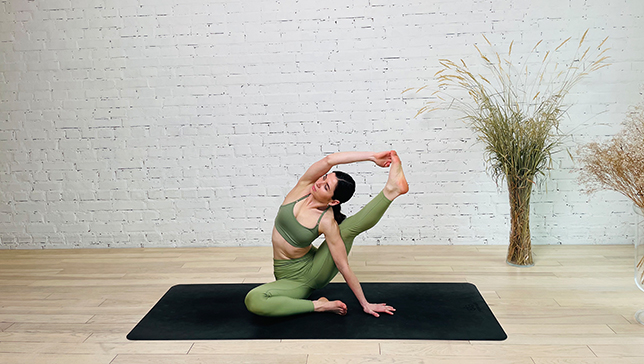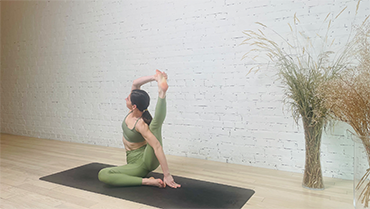Compass Pose - Parivrtta Surya Yantrasana

Contents
Compass Pose or Parivrtta Surya Yantrasana (Par-ee-vrt-tah SUR-yuH Yan-truh-AHS-anah ) is an intermediate to advanced seated posture with a twist that requires flexibility throughout the body. The name comes from the Sanskrit, parivrtta, meaning “revolved” or “twisted”; surya, meaning “sun”; yantra, meaning “instrument”; and asana, which translates as “pose” or “posture.”
In Parivrtta Surya Yantrasana, the drishti (gaze) can be straight ahead, but for a deeper twist, the gaze is toward the sky and over the upraised arm.
The pose is believed to open the svadisthana (sacral) chakra, which is associated with creativity and sexual energy. When svadisthana is balanced, the yogi experiences feelings of joy, wellness, pleasure, connection, abundance and transforming power.
Pose Detail
- Difficulty: Advanced, Intermediate
- Body Position: Arm & Leg Support, Seated Yoga Poses
- By Type: Flexibility Yoga Poses, Hip Opening Yoga Poses, Shoulder Opening Yoga Poses
- By Benefit: Yoga Poses For Stress Relief
Step-by-Step Instructions
Benefits and Contraindications
Relieves stress
Helps increase overall agility
Opening the hips and stretching the hamstrings
Stimulates the internal organs
Helps strengthen and lengthen the stabilizing muscles of your spine, maintaining spinal mobility
Sciatica
Hamstring injury
Back or spinal cord injuries
Shoulder injury
Groin injury
Photo poses in different angles

Modifications and Props for Beginners
If you are struggling too hard to hold the lifted foot with an alternate hand to stretch the leg in Compass Pose, then use a yoga strap.
Wrap a strap around the foot and hold it with the hand to stretch the leg upward. This will add extra length to the hand and make the stretch possible.
If the seated knee lifts up you can use a blanket or block to give it support.
Useful Tips
- One of the vital aspects of any yoga pose is breathing. Make sure that you are regulating your breathing during the Compass Pose.
- Do not worry if your pose looks different from the other people. Push your body to do better but not on the brink of injury.
- Honor the limits of your body. Warm-up before doing this pose will make your body more accessible to the Compass Pose.
Frequently Asked Questions
Compass Pose works on various muscles, including the hamstrings, glutes, hips, quadriceps, lower back, and core muscles.
Compass Pose is an advanced yoga posture that requires a great deal of flexibility, strength, and balance. It’s not recommended for beginners or those with limited flexibility.
To prepare for Compass Pose, you can practice other hip and hamstring openers. You can also work on strengthening your core, shoulders, and back muscles through other yoga poses and exercises.
Like any advanced yoga posture, Compass Pose can cause injuries if not done correctly or without proper preparation. It’s essential to warm up before attempting this pose and to listen to your body’s signals.
Yes, Compass Pose can be modified for beginners or those with limited flexibility by using props, such as a strap or block, to support your body and gradually work towards the full expression of the pose.
Variations
- Heron Pose
- Standing Compass Pose
- Archer Pose
- Head-to-Knee Pose A
- Compass Pose With A Strap